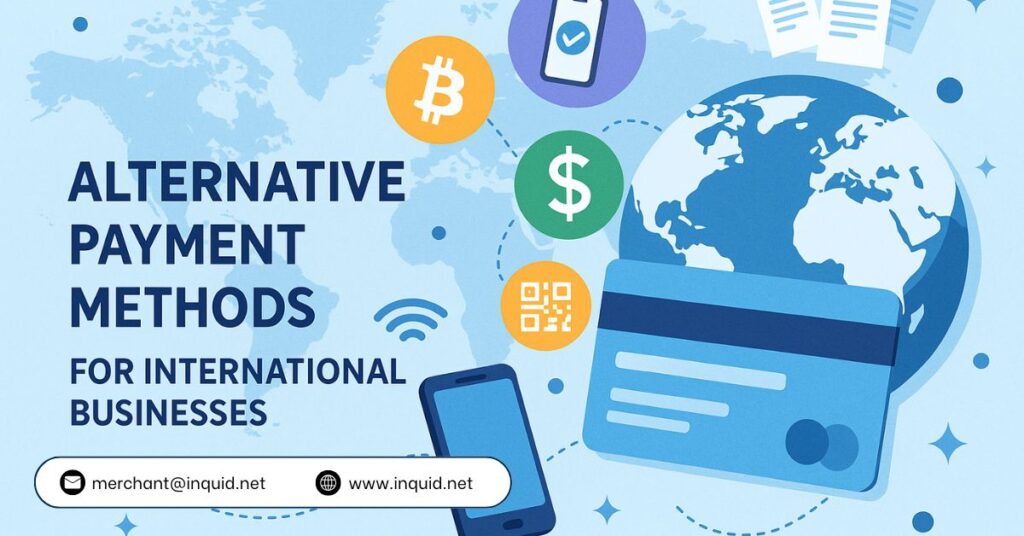
Breaking into international markets is more than just translating your website or shipping across borders. One of the most overlooked barriers to global sales is payment preference. Consumers around the world don’t pay the same way—and that’s why alternative payment methods for international businesses have become essential. If your business doesn’t support the methods buyers trust, they’re unlikely to complete the checkout.
That’s where alternative payment methods (APMs) matter. They offer businesses a way to connect with international buyers on familiar ground, respecting the habits and norms that drive transactions in each region.
What Counts as an Alternative Payment Method?
Alternative payment methods are any options outside of conventional credit or debit card payments. These may include:
- Digital wallets like PayPal, Skrill, Alipay, and WeChat Pay
- Mobile payment platforms such as Apple Pay and Google Pay
- Bank-based payments including real-time transfers, open banking apps, or local systems like iDEAL (Netherlands), POLi (Australia), or UPI (India)
- Buy Now, Pay Later options like Klarna and Afterpay
- Cryptocurrency for certain use cases or high-risk sectors
- Voucher and cash-based payments such as Boleto Bancário (Brazil) or OXXO (Mexico)
These options are increasingly becoming the standard in many countries—not the alternative. Relying solely on card acceptance can leave a significant number of global buyers behind.
Why Alternative Payment Methods Matter Internationally
Consumer trust and convenience are closely tied to payment habits. In markets like Germany, many customers prefer direct debit or bank transfers over cards. Meanwhile, in China, mobile payments via QR code have largely replaced both cash and plastic. In India, UPI transactions dominate the digital space.
Supporting alternative payment methods helps businesses:
- Connect with customers using familiar payment channels
- Cut down friction during checkout
- Compete more effectively with local businesses
- Increase conversion rates in unfamiliar regions
Even when your pricing is competitive, the absence of a familiar payment option can cause hesitation or lead to abandoned carts.
Local Preferences: A Quick Regional Snapshot
Let’s take a closer look at how payment preferences vary by region:
Europe
While cards remain widely used, several countries lean toward bank-based payments. For example, iDEAL processes the majority of online transactions in the Netherlands. German consumers frequently choose Sofort or Giropay. In addition, Buy Now, Pay Later options are seeing strong uptake among younger demographics.
Asia
China is driven by mobile-first payments. Alipay and WeChat Pay dominate the landscape and are essential for any serious market player. Although Japan still has a cultural attachment to cash, systems like Konbini are gradually expanding. Meanwhile, India’s UPI has drastically changed how both urban and rural populations transact.
Latin America
This region presents a unique challenge: many consumers are either unbanked or underbanked. To address this, voucher-based systems like Boleto in Brazil and OXXO in Mexico provide alternatives that bridge the gap between digital commerce and cash payments.
Middle East & Africa
Mobile-based financial tools are rapidly growing here. In Kenya, for instance, M-Pesa has redefined mobile money. Other countries are following suit, showing strong potential in digital wallet and mobile banking adoption.
Ignoring these preferences limits your ability to connect with buyers in high-potential regions.
How Businesses Can Approach APM Integration
Integrating APMs is not about offering every method available—it’s about choosing the right ones based on your market, audience, and product type. Here’s a practical approach:
- Identify your target markets. Start by examining where your audience is located and what payment systems they typically use.
- Align methods with buyer expectations. For example, crypto might resonate with digital-first audiences, while BNPL may appeal to younger consumers.
- Partner with the right provider. Not all platforms offer the flexibility and regional support needed. Work with a processor like inquid that has experience with international transactions and localized preferences.
- Measure and adapt. Track performance in each region, monitor drop-offs, and refine your setup based on real data.
To support this journey, inquid’s APMs solutions give businesses the tools and insight to expand without guesswork.
Beyond the Sale: The Real Impact of APMs
Alternative payments do more than complete transactions—they affect every stage of the customer journey.
- Lower cart abandonment: Customers are more likely to finalize a purchase when they see familiar payment methods.
- Faster processing: Local payment rails often avoid international banking hurdles, resulting in fewer delays.
- Less exposure to fraud: Several regional options come with built-in checks that reduce chargeback risks.
- Smarter decision-making: Regional performance data helps guide expansion plans and payment strategy.
For high-risk businesses, APMs also provide stability when card processors decline or delay approvals.
Final Thoughts
Selling across borders isn’t just about logistics—it’s about building trust. Customers expect to see the payment options they know and use. If those are missing, no amount of marketing or pricing will bring them back.
The right alternative payment methods give your business the flexibility to grow and connect globally. To see how your business can implement smarter options, explore alternative payment methods or review APMs solutions built for expanding businesses.
